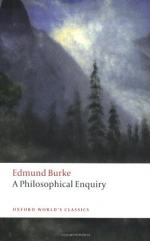
|
| Name: _________________________ | Period: ___________________ |
This quiz consists of 5 multiple choice and 5 short answer questions through Part III, Sections IX - XXVII.
Multiple Choice Questions
1. What does Burke assert about sensory observation?
(a) That divergent sensory observations of the same object are natural.
(b) That all people sense things in pretty much the same way.
(c) That sensory observation is of little importance to his discussion.
(d) That sensory input varies widely between individuals.
2. How does Burke define sympathy?
(a) As an unnecessary show of weakness that will cause pain.
(b) As a painful realization, and reasoned acceptance, of one's humanity .
(c) As a desirable state of mind reached by looking inward towards one's own soul.
(d) As a sort of emotional substitution between people or through art.
3. What is another word for the "fitness" of objects about which Burke writes?
(a) Condition.
(b) Utility.
(c) Aptitude.
(d) Health.
4. What is this creative power of the mind incapable of producing?
(a) Anything passionate.
(b) Anything truly new.
(c) Anything captivating.
(d) Anything of great consequence.
5. What example does Burke use to demonstrate that differing tastes stem from the same basic root?
(a) A comparison of two breeds of a horse.
(b) The comparison of two historical moments.
(c) Two different types of poetry.
(d) The description of pretty ladies in a drawing room.
Short Answer Questions
1. What large part of text has Burke added between the First and Second editions?
2. What does Burke hope will be the result of his "A Philosophical Enquiry Into the Origin of Our Ideas of the Sublime and Beautiful"?
3. To what does Burke oppose delicacy and fragility?
4. What example does Burke use in his argument that perfection is not the cause of beauty?
5. What examples does Burke use to argue that some sights are pleasurable to all people?
|
This section contains 407 words (approx. 2 pages at 300 words per page) |

|




